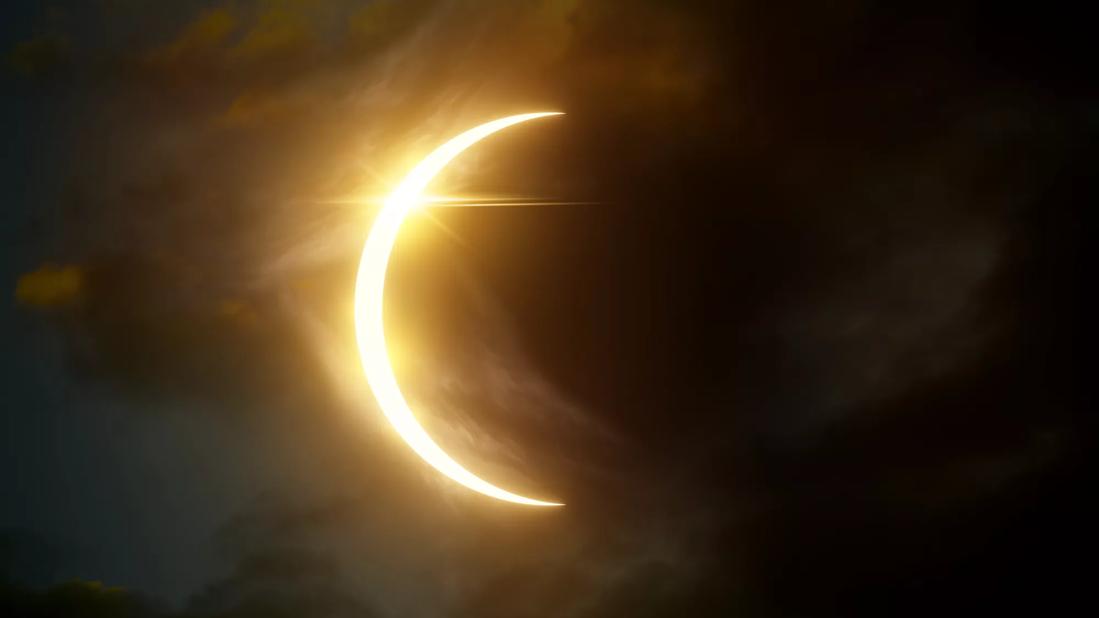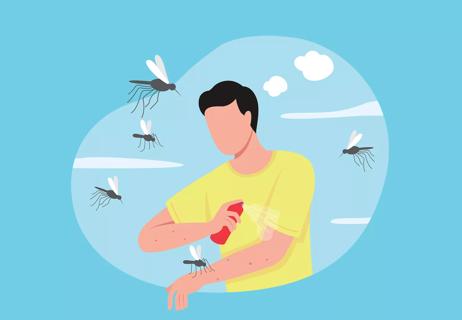It’s critical to have the proper eyewear if you plan to look up at the sun, especially during the total solar eclipse on April 8, 2024

A total solar eclipse is one of those magical moments that needs to be seen in order to be fully appreciated. Although there are roughly two to five solar eclipses each year, a total solar eclipse happens about once every 18 months. And depending on where you live in the world, you might only ever see one total solar eclipse in your lifetime unless you go out of your way to view it.
Advertisement
Cleveland Clinic is a non-profit academic medical center. Advertising on our site helps support our mission. We do not endorse non-Cleveland Clinic products or services. Policy
But beware: You can’t just sit back and throw your head up at the sun during a total solar eclipse. You need to have the right amount of protection for your eyes before looking directly at the sun. In fact, staring up at the sun at any time of the year can cause real, long-lasting, permanent damage to your vision, even if you’re looking at it for just a few seconds.
To safely prepare for the event, surgical ophthalmologist Nicole Bajic, MD, provides some tips on what eyewear you need to view a solar eclipse and what kind of damage can happen to your eyes if they’re not fully protected.
During a solar eclipse, the moon travels between the Earth and the sun. When this happens, the sun’s rays are temporarily blocked by the moon. The moon casts its shadow over parts of the Earth, blocking the surface of the sun from view for observers in very specific locations. Depending on the kind of solar eclipse, the moon’s shadow on the Earth’s surface can span up to 300 miles wide. But during a total solar eclipse, this shadow has two parts:
Advertisement
So, why are these details important to note? Well, when it comes to your eye safety, it’s only safe to look at the sun when it’s completely covered during those brief moments of totality. Totality can last for a few seconds up to a couple of minutes depending on several factors, including where you’re located, the tilt of the Earth and the position of the moon in orbit.
“You should check locally whether or not you’re in the path of totality, but it is only safe to look directly at the sun during a total solar eclipse when the sun is completely covered by the moon,” stresses Dr. Bajic. “As the moon moves across the sun, if there’s any part of the sun being exposed, you must be using specialized eye protection for solar viewing or you risk causing permanent damage to your vision.”
When you were a kid, did you ever use the lens of a magnifying glass to concentrate the sun’s rays to burn a hole through a piece of paper or to help start a small bonfire in the backyard?
Well, your eyes, contain similar lenses, and when you look directly up at the sun, that light is concentrated to hit your retina at the back of your eye.
Your retina is like the processing center of your eye — it helps capture light and translates it into the images that you see.
At the very center of your retina is your macula, the part that’s responsible for identifying specific details at the center of your vision like text on a page, specific colors or the differences between one person’s face and another.
So, when you concentrate your eyes on the sun and sunlight hits your eyes directly, you run the risk of burning a hole or causing damage to your macula, leading to all sorts of vision impairment that can include:
“Solar retinopathy is a permanent phototoxic injury to the eye that affects the macula that’s responsible for the central part of your vision, and this particular damage happens immediately in just a few seconds,” says Dr. Bajic.
“For some people, the damage can be temporary and it can resolve around three to six months. But for many people, unfortunately, it can be permanent, and that’s why we’re so passionate about eye safety.”
People who are at highest risk of solar retinopathy includes anyone with a history of:
“If you do find yourself accidentally looking at the sun, immediately look away,” advises Dr. Bajic. “And if you start experiencing any changes to your vision, follow up with an eye doctor who can determine a diagnosis and find out what’s causing those changes to occur.”
Advertisement
“Even though a total solar eclipse is exciting and rare, looking at the sun for even just a few seconds when it’s not completely covered can damage your vision for the rest of your life if you’re not wearing the right eye protection,” warns Dr. Bajic.
If you’re planning on looking directly at the sun, you want to make sure that you’re not looking at it directly with your naked eyes or using everyday sunglasses. The reason for this is because sunglasses aren’t dark enough to fully protect your eyes from direct sunlight.
For the same reasons, you also don’t want to look directly at the sun through a camera lens, telescope, binoculars, phone or any other optical device unless they have proper solar filters installed on the front of their cameras. If you’re unclear which solar filters are needed, expert advice from a local astronomer may be useful.
Otherwise, Dr. Bajic says the only safe way to look directly at the sun when it’s exposed is to use solar eclipse glasses with a filter designation of ISO 12312-2.
Solar eclipse glasses or handheld solar viewers with a filter designation of ISO 12312-2 are thousands of times darker than regular sunglasses, blocking all ultraviolet and infrared rays and nearly all visible light. These specific glasses should be worn whenever looking directly at the sun for any amount of time. But during an eclipse, they should be worn before and after totality.
Advertisement
You can only safely remove these solar eclipse glasses when the sun is completely covered. You’ll know when it’s safe to remove them when you can no longer see any part of the sun through your solar eclipse glasses or handheld solar viewer. And when you take them off, you’ll be able to see the moon covered in a ring of light as the sun’s rays shine around it.
“When you’re in the path of totality, the sun is completely blocked by the moon for a short amount of time,” explains Dr. Bajic. “You’ll see the darkness of the moon and then a soft glow around the moon during the total part of the solar eclipse. But at the very first hint of the sun peeking through, immediately look away and put your solar eclipse glasses back on.”
Additionally, Dr. Bajic reiterates that the only effective and safe solar eclipse glasses are the ones with a filter designation of ISO 12312-2 — anything sold without this designation online or in other stores is not recommended as safe eyewear protection.
If you’re unsure where to purchase the right solar eclipse glasses, the American Astronomical Society provides a list of approved vendors who offer the right products.
“There are a lot of counterfeit solar eclipse glasses floating around and, unfortunately, they’re not strong enough to keep your eyes safe from damage,” stresses Dr. Bajic. “You want to make sure you have the right filters before using them.”
Advertisement
Some people speculate whether or not you can or should view the solar eclipse through a camera, telescope, binoculars or other ocular device while wearing solar eclipse glasses. Dr. Bajic strongly recommends not doing this because the concentrated light through the lens can actually burn a hole through the filter of the glasses and cause severe eye damage.
In place of solar eclipse glasses, you can use a colander, perforated spoon or interlaced fingers to create a pinhole projection of the partial phases of the solar eclipse onto the floor or a plain white background until it’s safe to look at the sun directly. If you use the pinhole projection method, it’s important that you do NOT stare directly at the sun through the colander or other device you’re using.
Additionally, NASA offers instructions on how to create a pinhole projector box at home and other alternative methods for viewing the solar eclipse phases indirectly without solar eclipse glasses leading up to and immediately after the moment of totality.
“A total solar eclipse is an exciting event to witness with your own eyes, but it’s not worth sacrificing the safety of your eyes and your vision,” emphasizes Dr. Bajic. “If you are planning on being outside for a solar eclipse, or if you plan on doing some sungazing, make sure you have the right kind of eye protection ahead of time.”
And having the right kind of protection can even extend to your skin, too. The sun’s rays have a direct impact on the health of your skin — so much so that doctors recommend wearing sunscreen daily. If you plan on being outside for any length of time during the total solar eclipse, having sunscreen on hand is just as important as eyewear.
“Our dermatology colleagues recommend wearing sunscreen on sunny days and overcast days because we’re exposed to UVA and UVB radiation in both settings,” says Dr. Bajic. “You want to stay protected as much as possible, and getting in that habit is the most important thing because our level of exposure to the sun can really add up in the long term.”
Learn more about our editorial process.
Advertisement

What to do if you suddenly see lots of new ‘floaters’

Several conditions, like vitiligo and fungal infection, can cause a loss of pigmentation, leading to white spots or patches on your skin

Keep ‘mozzies’ at bay by avoiding scented body products, beer and certain colored clothes

Your bottom lip is 12 times more likely than your upper lip to get sunburned

This cooling gel can help soothe sunburned skin, but it can’t cure the burn

You know it’s not good if you’ve been holding onto it for more than three years or if it’s changed in color, consistency or smell

Wear light, breathable clothing, shower after you exercise and change your sheets regularly

The convenient option is good for touch-ups, but it shouldn’t replace your traditional sunscreen

The best parenting style balances enforcing rules and showing plenty of love

Tips include cutting back on sugar, focusing on exercise and managing stress

It can be harder to let go when you’ve invested time, energy and emotions — but it might be the healthier choice long term